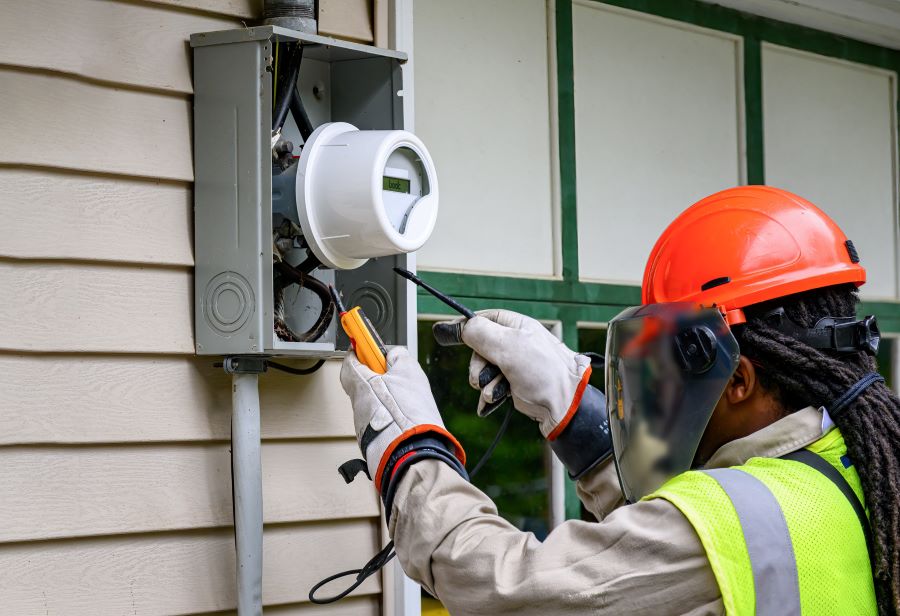Upgrading the electrical systems in retail spaces is crucial to maintaining a modern, safe, and efficient environment. This process involves several key steps, from evaluating current electrical needs to implementing advanced technology solutions. For retail business owners, understanding how to navigate these upgrades can significantly impact the effectiveness and customer satisfaction of their operations.
This article provides practical tips for effectively managing electrical upgrades in retail settings.
1. Assess Current Electrical Infrastructure
When initiating electrical upgrades in a retail space, the foremost action is a comprehensive evaluation of the current electrical setup. This critical phase involves meticulously examining and testing the existing electrical components, including the wiring, outlets, panels, and lighting systems. The focus should be not only on their age and overall condition but also on their capacity to meet current and future demands.
Retailers must take into account the unique electrical requirements of their business operations, which might include the necessity for enhanced lighting solutions or equipment with higher power needs. This thorough assessment is pivotal in pinpointing critical areas needing urgent upgrades and identifying elements that can be improved in subsequent phases. This strategic approach ensures that the electrical infrastructure aligns with current necessities and future business growth.
2. Engage A Professional Commercial Electrician
To ensure that electrical upgrades are conducted safely and effectively, it’s advisable to engage a professional commercial electrician. These skilled professionals can bring a wealth of knowledge and experience crucial for tackling the intricate aspects of retail electrical systems. Their expertise extends beyond technical know-how to include invaluable advice on the most efficient, cost-effective approaches to electrical upgrades. This includes strategic planning on energy consumption, modernization of systems, and integration of new technologies.
Moreover, these electricians ensure that all upgrades adhere strictly to local building codes and safety regulations, safeguarding against potential legal and safety issues. Involving a professional from the early stages of planning can help retailers avoid common mistakes, enabling a streamlined, hassle-free upgrade process. Their guidance is indispensable in ensuring that electrical systems aren’t only functional but also future-ready and compliant with regulatory standards.

3. Upgrade For Energy Efficiency
One of the primary goals of electrical upgrades in retail spaces is to improve energy efficiency. This reduces operating costs and contributes to a more sustainable business practice. Implementing energy-efficient solutions like LED lighting, advanced appliances, and automated energy management systems is crucial in substantially lowering electricity usage. These upgrades, though requiring an initial investment, aim to provide significant long-term financial benefits. Retailers are encouraged to focus on these potential savings, as the reduced energy consumption not only cuts costs but also aligns with environmentally friendly practices.
Prioritizing energy efficiency helps retailers balance economic savings with ecological responsibility, setting a standard for sustainable retail operations.
4. Incorporate Smart Technology
In today’s retail landscape, the adoption of smart technology is rapidly becoming essential. These advanced systems bring automation to key aspects like lighting, heating, cooling, and security, significantly enhancing comfort and safety for both customers and staff. Beyond the immediate operational improvements, smart technology stands out for its ability to gather and analyze data. This functionality enables retailers to make informed decisions, optimizing their operations from customer experience to energy management.
Additionally, integrating smart technology in electrical upgrades isn’t just about keeping pace with technological advancements; it’s about leveraging these tools to create more efficient, responsive, and customer-centric retail environments. The strategic incorporation of smart solutions is thus a forward-thinking move for any retailer planning electrical upgrades.
5. Ensure Safety And Compliance
Prioritizing safety and compliance is crucial during electrical system upgrades in retail environments. Retailers are responsible for ensuring that all modifications adhere strictly to local safety regulations and codes. This commitment involves meticulously installing electrical components under stringent safety protocols.
Furthermore, regular maintenance is essential to sustain the integrity and safety of the electrical infrastructure. All upgrades must also undergo thorough inspections and receive approval from the appropriate regulatory authorities. Such diligent adherence to safety standards provides a secure environment for customers and employees and shields the business from possible legal complications arising from non-compliance. This proactive approach to safety is fundamental to maintaining a trustworthy and responsible retail operation.
6. Plan For Future Needs
Forward-thinking is essential when upgrading electrical systems in retail spaces. It’s crucial to anticipate and accommodate future growth, technological advancements, and evolving customer demands. Retailers should focus on creating a flexible infrastructure that can easily adapt to these changes. This may include installing extra outlets to cater to new devices or equipment, enhancing electrical panels to support greater capacity, and preparing to integrate emerging technologies.
Planning for future needs ensures that retail spaces remain relevant, versatile, and ready to embrace new trends. Such foresight in planning makes retail environments current, resilient, and prepared for tomorrow’s challenges.
Conclusion
Electrical upgrades in retail spaces are a significant investment that can improve efficiency, safety, and customer experience. By keeping the tips mentioned above in mind, retailers can navigate these upgrades effectively. These steps will help create a retail environment that’s functional, safe, forward-thinking, and adaptable to future advancements in technology.





